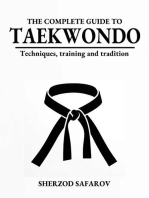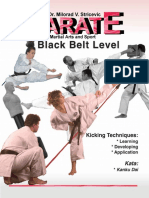0 ratings0% found this document useful (0 votes)
61 viewsTaekwondo Report
Taekwondo Report
Uploaded by
rynowaandreaademTaekwondo is a Korean martial art that originated thousands of years ago. The earliest organized training developed around the 1st century AD during the rule of the Three Kingdoms in Korea. While its origins are unclear, taekwondo was likely practiced as early as 5000 years ago using bare hand fighting techniques. It was used for self-defense, hunting, and strengthening the body. Today, the main international organizations governing taekwondo are the International Taekwon-Do Federation and the World Taekwondo Federation.
Copyright:
© All Rights Reserved
Available Formats
Download as PPTX, PDF, TXT or read online from Scribd
Taekwondo Report
Taekwondo Report
Uploaded by
rynowaandreaadem0 ratings0% found this document useful (0 votes)
61 views15 pagesTaekwondo is a Korean martial art that originated thousands of years ago. The earliest organized training developed around the 1st century AD during the rule of the Three Kingdoms in Korea. While its origins are unclear, taekwondo was likely practiced as early as 5000 years ago using bare hand fighting techniques. It was used for self-defense, hunting, and strengthening the body. Today, the main international organizations governing taekwondo are the International Taekwon-Do Federation and the World Taekwondo Federation.
Copyright
© © All Rights Reserved
Available Formats
PPTX, PDF, TXT or read online from Scribd
Share this document
Did you find this document useful?
Is this content inappropriate?
Taekwondo is a Korean martial art that originated thousands of years ago. The earliest organized training developed around the 1st century AD during the rule of the Three Kingdoms in Korea. While its origins are unclear, taekwondo was likely practiced as early as 5000 years ago using bare hand fighting techniques. It was used for self-defense, hunting, and strengthening the body. Today, the main international organizations governing taekwondo are the International Taekwon-Do Federation and the World Taekwondo Federation.
Copyright:
© All Rights Reserved
Available Formats
Download as PPTX, PDF, TXT or read online from Scribd
Download as pptx, pdf, or txt
0 ratings0% found this document useful (0 votes)
61 views15 pagesTaekwondo Report
Taekwondo Report
Uploaded by
rynowaandreaademTaekwondo is a Korean martial art that originated thousands of years ago. The earliest organized training developed around the 1st century AD during the rule of the Three Kingdoms in Korea. While its origins are unclear, taekwondo was likely practiced as early as 5000 years ago using bare hand fighting techniques. It was used for self-defense, hunting, and strengthening the body. Today, the main international organizations governing taekwondo are the International Taekwon-Do Federation and the World Taekwondo Federation.
Copyright:
© All Rights Reserved
Available Formats
Download as PPTX, PDF, TXT or read online from Scribd
Download as pptx, pdf, or txt
You are on page 1of 15
TAEKWONDO
Taekwondo Literally means
The “Art of hand and foot fighting"
The origin of Taekwondo is obscured by
many thousands of years of Korean history.
The first organized development of
Taekwondo martial arts training is thought
to be around the first Century on the
peninsula of Korea over 2000 years ago
when the Three Kingdoms (Silla, Goguryeo
and Baekje) ruled. However, it is estimated
that Taekwondo was practiced in a primitive
form of martial art style in ancient times as
far back as 5000 years ago. In those ancient
times, there was no means of self defense
other than bare hands and the body for a
weapon. So it was natural to assume that
The origin of Taekwondo is
obscured by many thousands of
years of Korean history. The first
organized development of
Taekwondo martial arts training is
thought to be around the first
Century on the peninsula of Korea
over 2000 years ago when the Three
Kingdoms (Silla, Goguryeo and
Baekje) ruled. However, it is
estimated that Taekwondo was
practiced in a primitive form of
martial art style in ancient times as
far back as 5000 years ago. In those
ancient times, there was no means
of self defense other than bare
hands and the body for a weapon.
So it was natural to assume that
bare-hand fighting martial art
techniques were developed.
It is suggested that Taekwondo was first practised as a method
of evading attacks from wild animals as well as a useful tool in
hunting for food and also as a means of strengthening the
body. Martial art techniques were learned from the experience
of fighting against beasts whose defensive and offensive
motions were the subject of analysis and mimicking. Since
attacks could originate from any direction, martial art moves
were developed that allowed reflexes to counter from any
direction. Specific patterns were formed for instinctive self
defence which became a series of blocks, kicks and strikes.
These patterns are still practised today.
There is some speculation that the martial art
style of Taekwondo is not indigenous to Korea
and that it is a break off of Chinese and other
Asian martial arts. The legendary origins of the
Eastern (Chinese) martial arts are generally
ascribed to a Monk from India called
Bodhidharma. According to legend and ancient
Chan Buddist texts, Bodhidharma came to China
in the Sixth Century AD where he founded a
monastery at Shaolin-So. He began to teach
breath control and meditation. But his followers
were physically incapable of practising the
strenuous techniques, so he taught them
methods of strengthening their bodies and their
spirit. These methods later combined with
Taoism and I-Ching to form the basis for the
Chinese martial arts of Kung Fu, Kempo and Tai
Chi Chuan.
In Korea, the first tangible evidence of Taekwondo
dates from the Three Kingdoms period where a mural
painted on the wall of the Myung-Chong tomb located
in Tunsko (Capital of Goguryeo) and built in the
Goguryeo Kingdom sometime in the First Century .
The mural shows two youths sparring. Other tombs
found in this period contain similar murals which show
figures practising martial arts. Accordingly, there is
evidence that Korea was developing it's own martial
art well before Bodhidharma arrived in China and it
seems that the martial art style of Taekwondo is of
Korean origin.
The "Three Kingdoms There
were Three Kingdoms which
separately ruled the Korean
Peninsula at the beginning of
the first Century: Goguryeo,
Baekje and Silla. These
kingdoms were sometimes at
war with each other until
Silla took over Baekje in mid
7th Century and Goguryeo in
the late 7th Century thus
unifying the Korean nation.
The Silla dynasty lasted until
10th Century.
The main international
organizational bodies for
Taekwondo today are the
International Taekwon-Do
Federation (ITF), founded by
General Choi Hong Hi in 1966,
and the World TaeKwonDo
Federation (WTF), founded in
1973 by the KTA
Choi Hong-hi (9 November 1918 – 15
June 2002) was a South Korean Army
general, and martial artist who was
an important figure in the history of
the Korean martial art of Taekwondo
The body known for taekwondo in the
Olympics is the World Taekwondo Federation.
WHITE BELT (10th kup) signifies innocence and purity as
the student has no previous knowledge of Taekwondo.
YELLOWE BELT (8th kup) signfies gold: an element of the
Earth. Gold in turn represents truth and foundation of
Taekwondo.
GREEN BELT (6th kup) signifies growth as Taekwondo
skills begin to grow and develop.
BLUE BELT (4th kup) signifies heaven as the student
matures and progresses in training.
RED BELT (2nd kup) signifies the sun, the centre of our
solar system. Red also signifies danger cautioning the
student to exercise control and warning the opponent to
stay away.
BROWN BELT - The tree is firmly rooted in the Earth.
BLACK BELT (1st Dan) is the opposite of white signifying
maturity and proficiency in Taekwondo. It also indicates the
wearer's invulnerability to darkness and fear. Black
represents the Universe.
THE FITNESS
The principles of Taekwondo techniques
BENEFITS are based on the design of your body.
OF For power you develop the larger,
TAEKWONDO powerful muscles of the torso. The
speed of the techniques comes from
the fast, agile muscles of the arms and
legs. As you progress in Taekwondo, you
will learn to coordinate this speed and
power, and develop the concentration
to focus all of your body's strength into
a small, hard striking surface like the
edge of the hand or the heel of a foot.
THE SELF-DEFENSE
BENEFITS When the speed and power
developed through Taekwondo is
OF used in a self-defense situation
TAEKWONDO against the vulnerable parts of an
attacker's body, the results can
be incredible. Taekwondo allows
a woman to emphasize many of
her natural physical strengths,
such as power in the legs, while
learning a method of self-defense
efficient against a much larger
opponent.
THE SELF- CONFIDENCE
BENEFITS This does not come naturally for
OF many people, but self-confidence
TAEKWONDO can be developed over a period of
time. Through Taekwondo as you
accomplish new goals, your
confidence level increases.
Taekwondo instills a sense of
discipline and self-confidence that
can carry over to all aspects of
your life.
That's all thank you for listening!
You might also like
- Taekwondo Basics: Everything You Need to Get Started in Taekwondo - from Basic Kicks to Training and CompetitionFrom EverandTaekwondo Basics: Everything You Need to Get Started in Taekwondo - from Basic Kicks to Training and CompetitionRating: 5 out of 5 stars5/5 (1)
- Independent Tang Soo Do Association: Yu Gup Ja Training ManualDocument54 pagesIndependent Tang Soo Do Association: Yu Gup Ja Training Manualbrendan lanzaNo ratings yet
- LMA Taekwondo Hapkido ManualDocument50 pagesLMA Taekwondo Hapkido ManualNoel Gilchrist100% (7)
- Martial Arts Final Written ReportDocument18 pagesMartial Arts Final Written ReportBettinaaaNo ratings yet
- Data HP Authorised Retail StoresDocument2 pagesData HP Authorised Retail StoresParas SatijaNo ratings yet
- Week 1 To 5 Prelim 1st SemDocument22 pagesWeek 1 To 5 Prelim 1st Semavi901136No ratings yet
- Pe TaekwondoDocument4 pagesPe TaekwondoalliahnahNo ratings yet
- Phed TKDDocument39 pagesPhed TKDcutieNo ratings yet
- Literature ReviewDocument5 pagesLiterature Reviewapi-549127950No ratings yet
- Mtphed1 3Document4 pagesMtphed1 3Kyle SoveranoNo ratings yet
- Pe 1 Fundamentals of Martial ArtsDocument26 pagesPe 1 Fundamentals of Martial ArtsRovi Clarito100% (6)
- TaekwondoDocument38 pagesTaekwondoJohn OliquianoNo ratings yet
- Chapter 4Document7 pagesChapter 4VILLANUEVA, MARIALYN BNo ratings yet
- Taekwondo Thesis 4th DanDocument4 pagesTaekwondo Thesis 4th Danmaureennonweilertulsa100% (2)
- Lesson Plan TaekDocument39 pagesLesson Plan Taekregielyn ruedasNo ratings yet
- A Brief History of TaekwondoDocument12 pagesA Brief History of TaekwondoJoe WillertNo ratings yet
- Assignment in Spe 118BDocument2 pagesAssignment in Spe 118BShiela Mae CastinNo ratings yet
- Taekwondo The Art of MartialDocument3 pagesTaekwondo The Art of MartialFahmi Fahrurroji100% (1)
- (PE) TaekwondoDocument4 pages(PE) Taekwondoaz.hbizNo ratings yet
- Martial ArtsDocument19 pagesMartial Artsalcodark100% (1)
- What Is Taekwondo: (Or 'To Step On Fists')Document5 pagesWhat Is Taekwondo: (Or 'To Step On Fists')Pedro ChavezNo ratings yet
- History of Taekwondo in MalaysiaDocument17 pagesHistory of Taekwondo in Malaysiaiffah16100% (1)
- Student HandbookDocument26 pagesStudent HandbookChetanya MundachaliNo ratings yet
- TaekwondoDocument3 pagesTaekwondodikoalamNo ratings yet
- PresentationDocument44 pagesPresentationMhiahLine TolentinoNo ratings yet
- Combat SportsDocument6 pagesCombat SportsOwen MabutolNo ratings yet
- The Structured Curriculum of ITF TKDDocument5 pagesThe Structured Curriculum of ITF TKDBrian Le Vu100% (2)
- Taekwondo: Engage & DiscussDocument16 pagesTaekwondo: Engage & DiscussAljo Cabos GawNo ratings yet
- Group 1Document16 pagesGroup 1Kaiser Jacob FlorescaNo ratings yet
- TaekwondoDocument6 pagesTaekwondoLezeilNo ratings yet
- A Brief History of TaekwondoDocument3 pagesA Brief History of Taekwondoganica castroNo ratings yet
- Tae Kwon DoDocument6 pagesTae Kwon DoOremor YmerNo ratings yet
- Introduction of TaekwondoDocument7 pagesIntroduction of TaekwondoKen Lip YamNo ratings yet
- TaekwondoDocument7 pagesTaekwondoJan Carlo PascuaNo ratings yet
- StudentmanualDocument32 pagesStudentmanualAslyn WoodfordNo ratings yet
- Taekwondo, 10 9Document2 pagesTaekwondo, 10 91946688564No ratings yet
- Taekwondo oDocument6 pagesTaekwondo oAnn Dela PiezaNo ratings yet
- TaekwondoDocument15 pagesTaekwondoscripduser1973100% (2)
- TaekwondoDocument2 pagesTaekwondoMin YoongiNo ratings yet
- History of Taekwand1Document3 pagesHistory of Taekwand1Eka MagsigayNo ratings yet
- What Is TaekwondoDocument2 pagesWhat Is TaekwondoLibagon MpsNo ratings yet
- Taekwondo in A NutshellDocument8 pagesTaekwondo in A NutshellRepublic of Korea (Korea.net)100% (2)
- Lesson 1 Combat SportDocument4 pagesLesson 1 Combat SportRoselyn PillosNo ratings yet
- Basic Self Defense - LessonsDocument4 pagesBasic Self Defense - LessonsROMAH JANE MENDOZANo ratings yet
- TaekwondoDocument8 pagesTaekwondoJan Carlo Pascua0% (1)
- TAEKWONDODocument12 pagesTAEKWONDONikka Dela CruzNo ratings yet
- The Ultimate Taekwondo Handbook: Training, Techniques and PhilosophyFrom EverandThe Ultimate Taekwondo Handbook: Training, Techniques and PhilosophyNo ratings yet
- Introduction of TaekwondoDocument28 pagesIntroduction of Taekwondoalex100% (1)
- Taekwondo Thesis 1st DanDocument5 pagesTaekwondo Thesis 1st Danafcmunxna67% (3)
- TKD UsaDocument36 pagesTKD UsaJose Pablo VenegasNo ratings yet
- CTKD Hand BookDocument36 pagesCTKD Hand BookNatanael CamargosNo ratings yet
- Reporte en Inglés Sobre El KarateDocument3 pagesReporte en Inglés Sobre El KaratePaz FloresNo ratings yet
- The Complete Guide to Taekwondo: Techniques, Training, and TraditionFrom EverandThe Complete Guide to Taekwondo: Techniques, Training, and TraditionNo ratings yet
- Karate Martial Art and Sport Black Belt Level - Dr. Milorad V. StricevicDocument433 pagesKarate Martial Art and Sport Black Belt Level - Dr. Milorad V. Stricevicbearmiinator80% (5)
- Research PaperDocument12 pagesResearch Paperapi-549127950No ratings yet
- History of Taekwondo and Hand Attacks.Document4 pagesHistory of Taekwondo and Hand Attacks.Niña LoricoNo ratings yet
- History of Taekwondo As Martial Arts and As Fitness: Tenebro, Hannah A. Bsce 1 7815 FIT CS 3:30-5:30Document3 pagesHistory of Taekwondo As Martial Arts and As Fitness: Tenebro, Hannah A. Bsce 1 7815 FIT CS 3:30-5:30Jansen Taruc NacarNo ratings yet
- Taekwondo1 2013Document30 pagesTaekwondo1 2013Aliff MansorNo ratings yet
- Basics of Taekwondo: Prepared By: Juli Marie B. Galicia, LPT, Jendley Grace A. Pascua and Alvin T. PeraDocument32 pagesBasics of Taekwondo: Prepared By: Juli Marie B. Galicia, LPT, Jendley Grace A. Pascua and Alvin T. PeraMery Ong BenitezNo ratings yet
- Taekwondo Taekwondo (태 권 도 ;Document10 pagesTaekwondo Taekwondo (태 권 도 ;zazasharkNo ratings yet
- MTB ListDocument20 pagesMTB ListyassineNo ratings yet
- Lolo September 16-30Document1 pageLolo September 16-30Denielle Casimiro RabanezNo ratings yet
- Food TechniquesDocument2 pagesFood TechniquesflordetoxoNo ratings yet
- Grade 9 Peer Review Sheet RevisedDocument3 pagesGrade 9 Peer Review Sheet Revisedapi-291290415No ratings yet
- 01 Performance Task Prelim ARGDocument50 pages01 Performance Task Prelim ARGArwin HernandezNo ratings yet
- Noah Carr - ResumeDocument1 pageNoah Carr - Resumeapi-639527273No ratings yet
- Early Letters Robert Schumann PDFDocument352 pagesEarly Letters Robert Schumann PDFIria CaamañoNo ratings yet
- Philippine Folk Dances - HistoryDocument5 pagesPhilippine Folk Dances - HistoryRasalyn Cericos Valois0% (1)
- Return To The Keep On The BorderlandsDocument68 pagesReturn To The Keep On The BorderlandsCellgamer666100% (3)
- Euripides: Ke Is F - 4Document267 pagesEuripides: Ke Is F - 4Roberto Revert SorianoNo ratings yet
- Fandom As FortressDocument9 pagesFandom As FortressKeiley ColpoysNo ratings yet
- Symbaroum Character Sheet PDFDocument2 pagesSymbaroum Character Sheet PDFdespistado38No ratings yet
- Soal Pas Genap Bahasa Inggris Tahun Pelajaran 2021Document2 pagesSoal Pas Genap Bahasa Inggris Tahun Pelajaran 2021gusti madeNo ratings yet
- Nike From Concept To CustomerDocument9 pagesNike From Concept To CustomerJigyasa GautamNo ratings yet
- MRT3 Train Time Schedule & Line Map: Taft Avenue - North AvenueDocument4 pagesMRT3 Train Time Schedule & Line Map: Taft Avenue - North AvenueMark MissionNo ratings yet
- Writing Lessons Answer Key: 1 Forms Student's Book Pages 150-151 2 Pen Friends Student's Book Pages 152-153Document3 pagesWriting Lessons Answer Key: 1 Forms Student's Book Pages 150-151 2 Pen Friends Student's Book Pages 152-153Eyad SobehNo ratings yet
- Ring Beam Shoring System 25oct06Document14 pagesRing Beam Shoring System 25oct06Seng SiongNo ratings yet
- The Greek and Roman TheatreDocument5 pagesThe Greek and Roman TheatreAndreeaNo ratings yet
- Emperor Raja RAja CholanDocument2 pagesEmperor Raja RAja CholanKayalvizhi ArulandhuNo ratings yet
- MAGAYON HINUPTANAN FESTIVAL 2023-DepEd NightDocument2 pagesMAGAYON HINUPTANAN FESTIVAL 2023-DepEd NightFrankie Snook Bravo IIINo ratings yet
- Jet Airways Web Booking ETicket (PLTPWV) - LoboDocument3 pagesJet Airways Web Booking ETicket (PLTPWV) - LoboAamir KhanNo ratings yet
- Dilg 911 - Ict - Tech SpecsDocument6 pagesDilg 911 - Ict - Tech SpecsEdcel EmerencianaNo ratings yet
- Dragon Chasers Hit ChartDocument2 pagesDragon Chasers Hit ChartChaoran ChengNo ratings yet
- Softgamings Brochure 2020 SmallDocument24 pagesSoftgamings Brochure 2020 SmallscribNo ratings yet
- EA QualifiedDocument286 pagesEA Qualifiedmohanagauthaman3306No ratings yet
- PET PLUS 2-T4-E-12 BanDocument4 pagesPET PLUS 2-T4-E-12 Ban09-Nguyễn Hữu Phú BìnhNo ratings yet
- The 'Leftennant Cross' 32nd Note Gospel ChopDocument7 pagesThe 'Leftennant Cross' 32nd Note Gospel ChopMichael JohnsonNo ratings yet
- 5-Day Deck. Design Sprint XDocument108 pages5-Day Deck. Design Sprint XgevalindaNo ratings yet
- List of Dungeons and Dragons ModulesDocument15 pagesList of Dungeons and Dragons Modulesgustav_goodstuff8176100% (1)

























































































